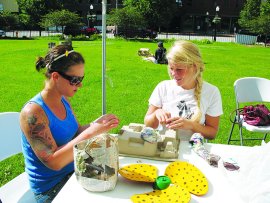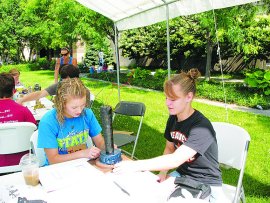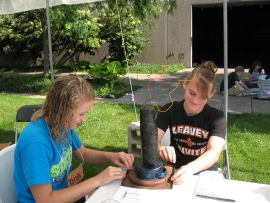 After
digging through piles of water bottles, cardboard boxes, plastic
forks, and take-out cartons lying near the tent, Samantha Dickey last
week began to build a model for a sculpture. "Right now we are
trying to come up with some ideas to make our main sculpture for the
site that we have," said the soon-to-be-sophomore from North Scott
High School. "My idea was to make a water fountain out of the
tires."
After
digging through piles of water bottles, cardboard boxes, plastic
forks, and take-out cartons lying near the tent, Samantha Dickey last
week began to build a model for a sculpture. "Right now we are
trying to come up with some ideas to make our main sculpture for the
site that we have," said the soon-to-be-sophomore from North Scott
High School. "My idea was to make a water fountain out of the
tires."
Dickey and 13 other high-school students in the sculpture portion of the Quad City Arts Metro Arts Summer Youth Program will be creating a sculpture out of recycled material to go on display July 10. Although each student is making a model of an idea, the group decided on a concept by Tina Eden, who will be a senior at Moline High School, and Brittany Paller, a recent graduate of Moline, because it was the most mobile. The sculpture will appear at the front entrance of the River Roots Live festival in August and will most likely be on display on Arsenal Island, although the site hasn't been confirmed yet.
Each of the models is created out of used goods - such as bottle caps, masking tape, and cardboard food boxes - that Heidi M. Sallows, the program's teacher and a local "green" artist, gathered from her studio. "I didn't think we were going to be using all trash," said Molly Cathcart, who will be a senior at Geneseo. "I thought we were going to have a base of something else. I never thought of using this stuff to make art out of."
Dickey agreed: "I've never heard of it [green art] before, actually. I usually just call it trash-to-treasure kind of stuff. I never even heard it called the green anything."
While these students are just beginning to learn about green art, artists already working in the genre said it allows them to display their concern for the environment.
Kara Fedje, a local fiber artist, originally wanted to go into environmental law. After moving back to the Quad Cities to attend Augustana College, which didn't offer the type of program she wanted, she earned a degree in art, she said. Green art gave her the chance to show her passion for environmental and social issues, Fedje said.
Sallows, on the other hand, was inspired by other artists. In college, she was introduced to green art when she was studying Mel Chin, who made a sculpture that used plants to detoxify part of a landfill.
 Green
art also provides a cheaper way of doing art than the traditional
painting and sculpting, said Elise Hoehn, a local salvage artist. "I
started out doing this as a college student," she said of recycled
art. "You really can't afford it [traditional media]. Paint,
canvas - it gets expensive and that's even before you start
working."
Green
art also provides a cheaper way of doing art than the traditional
painting and sculpting, said Elise Hoehn, a local salvage artist. "I
started out doing this as a college student," she said of recycled
art. "You really can't afford it [traditional media]. Paint,
canvas - it gets expensive and that's even before you start
working."
Even the Metro Arts students are noticing the low cost of recycled art. "You don't need to spend much money on the different objects," said Dickey. "All you have to do is go out to your backyard or collect pop bottles or anything that you like ... ."
Artists have been using recycled material in their work for decades. Green art started in the 1960s when artists began to question the restriction of traditional methods to create art, explains Greenmuseum.org, a Web site about green art. The site says the artists started experimenting with manipulating the land and using natural materials for their sculptures - a method now called "environmental art." Green art has expanded to include eco-art and salvage art. Eco-art uses biology - such as plants and insects - to create and build awareness of ecological systems. Salvage artists make sculptures out of recycled material, such as the sculpture for the Metro Arts program.
While she said she typically works with items that are harder to recycle, such as Styrofoam and computer parts, Hoehn, like other salvage artists, works with a variety of materials, including metals and cardboard. "You're taking something that usually people would just say, 'Oh that's trash. Throw it away.' But you see it from a different point of view," Dickey said.
Although she doesn't limit herself to textiles, Fedje has created entire works out of reused fabric. She said she used the old drapes and carpet from a house her mother bought, but she also added a few items that she had around her own house, such as old T-shirts and a weaving that was original going to be a bag, she said.
Even though salvage artists' materials can be found anywhere, artists struggle to find ways to collect and store their items. "It's probably the hardest thing in using recycled art as a medium ... ," said Fedje. "So to collect all these materials and things like that, you have to kind of have a place to store them. You [also] have to have a way to collect them. When people are willing to work with you, that's awesome."
Hoehn said she finds that most people are willing to give away their garbage if they're asked. When she sees an object she could use, such as a computer, sitting near someone's trash, she will knock on their door and ask to take it off their hands, she said. People are usually happy to give away items to avoid a disposal charge.
Sallows has friends and neighbors who regularly drop off objects at her house, she said. When working on the Mississippi Palette project, Sallows included material people gave her, including three wedding dresses, which she made into clouds for her sculpture River Relief. The Mississippi Palette was a project during the spring and summer of 2007 that paired high-school and college students with 10 local artists to create sculptures primarily out of trash from the Mississippi River.
Other times, salvage artists reuse their own work. Hoehn creates only temporary sculptures, allowing her to recycle her work from past shows. "Junk is great," she said. "After I do a show, you can almost pitch it all in a U-Haul and not even worry about it being scratched, unless someone is going to buy it, because it's going to be reused in another piece, in another show."
After visiting the site last week where the larger sculpture for the Metro Arts program will probably be displayed, the students created models or sketches. Some of the students chose an idea based on the people they think will most likely see the sculpture. "We are kind of going for a family thing, because we're thinking people down there will mostly come with their families, like on vacation or something like sightseeing," said Eden, who was designing a model of a picnic scene with Paller.
 Other
students derived inspiration from the topography of the area.
Cathcart was making a model of a mermaid, envisioning her lying on
the site's rocks, she said. "All the recycled material would make
it pretty," she said.
Other
students derived inspiration from the topography of the area.
Cathcart was making a model of a mermaid, envisioning her lying on
the site's rocks, she said. "All the recycled material would make
it pretty," she said.
Similar to how the students in the Metro Arts program will use their recycled items, Sallows likes to keep her materials in the state she found them. She uses the objects' recognizability as a way to get her audience to think about the nature of the objects.
"Right now, it is about garbage for me," she said. "It is about trash, and I want people to think about that." In her piece for the Mississippi Palette project, Sallows created a ri ver scene of a man walking out of the water with a bag, while a woman waits on shore and a boat floats on the river. She made the entire sculpture, which is on display at the Putnam Museum until August, out of everyday objects, such as bottles, plastic bags, and basketballs. An unfinished piece she called Trash Bride was made out of plastic bags from a flower shop, wires, clothes hangers, and tape, she said.
Hoehn takes a different approach to her work, utilizing her sculptures to inspire her audience and show people that everyday items can be transformed into a new piece with a "higher sense of form in the artwork," she said. She paints each sculpture a separate color so she can unify the structure and help her audience focus on the individual piece. "All my pieces I've shown ... together, but when the observer looks at them, I want them to look at them as individual pieces, and that's why they are all different colors," she said. But "when they do look at a piece, I want them to have an immediate reaction, whether it's a feeling or a mood or an 'I like it/I don't like it' or a reminisce," she said.
Still other artists use their work to give a message about environmental issues to their audience. Local artist Bill Wohlford had his Mississippi Palette piece What Goes Around Comes Around - which is a Ferris wheel made out of grocery carts, currently on display in front of a Bettendorf recycling center at 4403 Devils Glen Road - demonstrate how "everything we throw away starts out in a grocery cart," he said. Eventually, we have to deal with the consequences of using each item we buy, he said.
Each cart contains a group of items that represent how mankind is damaging the environment. One cart holds aerosol cans to represent the depletion to the ozone layer, while another has a car bumper to stand for air pollution. "I think we need to be aware of the fragile nature of our environment," said Wohlford. "Each of us, as individuals, needs to understand that we are all just borrowing this Earth of ours for a short time, and we need to leave it in at least the same conditions that we found it."










